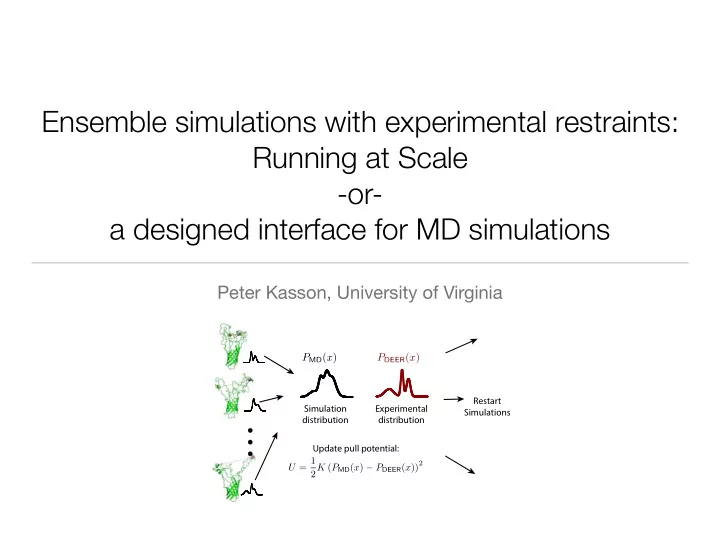

Ensemble simulations with experimental restraints: Running at Scale -or- a designed interface for MD simulations Peter Kasson, University of Virginia Restart Simulation Experimental Simulations distribution distribution � Update pull potential:
Motivation: • Most molecular dynamics simulation packages are monolithic • Most applications are not • How can we enable flexible, performative use of large- scale MD simulations?
Motivation II • Custom modifications of MD code are common, e.g. to implement additional potentials for experimental data • Having open code that can be modified is great • Having everyone modify it is a Bad Idea for barrier-to- entry, performance, reproducibility, maintainability • Goal: custom modifications with no changes to core MD code. HACKS
Motivation III • Not just another Python API • Design inspiration from TensorFlow (API compatible) • Procedural commands set up a computational graph • Enables user-transparent performance optimizations Image: deepideas.net
Motivation IV • Ensembles as first-class entities, computational context abstracted • Description of what to execute should be distinct from specification of where to execute. run parameters clusters, simulation run inputs collective variables run inputs trajectories ... input simulation trajectory trajectory sampling & setup structures setup analysis analysis for new simulations MD (colvars, (colvars, simulations MD clustering) clustering) simulations ensemble results
gmxapi: Python (and more) API for Gromacs • Running molecular dynamics simulations • Clean interface that permits scalable, optimized execution with standard or custom code • Build and execute a computational graph
What does this mean in practice? import gmx import myplugin md = gmx.workflow.from_tpr(tpr_list) potential = gmx.workflow.WorkElement( namespace="myplugin", operation="ensemble_restraint", depends=[], params=params) potential.name = "ensemble_restraint_1" md.add_dependency(potential) context = gmx.context.ParallelArrayContext(md) Simple, clean code. with context as session: This runs an ensemble of simulations session.run() using a custom potential.
A peek under the hood Data Input a gmxapi.load_file params: [filename1 , filename2 , ...] >>> md = gmx.from_file ([ filename1 , filename2 , filename3 , ...]) MD Engine gmxapi.md b Data Input >>> potential = myplugin. EnsembleRestraint ( sites , * args , ** kwargs ) Plug-in module myplugin.mdmodule params: [...] MD Engine >>> md . add_dependancy ( potential ) Calculation on ensemble gmxapi.ensemble_reduce params: [SUM] c Execution manager >>> gmx.run () Data Input MD Engine Plug-in module Calculation on ensemble
Custom potentials are easy(ish) • Boilerplate C++ code, en route to templated classes • essentially implement a calculate() method and then an update callback to update potentials for adaptive approaches.
What this enables • Implementation of restrained-ensemble simulation (Roux, 2013) • Simple, scalable execution within 5% of native code performance. • Can either execute multiple iterations with independent ensemble members or update potentials with a (blocking) reduce
Example of restrained-ensemble simulation Ensemble of 20 simulations ensemble reduce & potential update every 100 ps Continue Restart Simulation Experimental simulations Simulations distribution distribution � Update pull potential: Hays et al., 2018
Example of restrained-ensemble simulation and convergence a) 31 - 166 Convergence to experimental 88 - 162 distributions (Assessed via histograms, Probability Jensen-Shannon divergence) 77 - 107 117 - 107 Distance (nm) MD Initial DEER b) 31-166 0.4 88-162 J-S Divergence 77-107 117-107 0.2 0.0 Hays et al., 2018 0 100 50 Time (ns)
Current status • Functionality: Can run ensembles, enable custom force plugins, perform ensemble reduce as needed. • Implementations: Two different ensemble-biasing algorithms implemented, working on automated umbrella sampling next. • Alpha/beta code release github.com/kassonlab/gmxapi • (almost) running on Blue Waters • Next round of functionality in progress. Taking requests.
We want to hear from you! • gmxapi manuscript: Irrgang et al., 2018 doi:10.1101/306043 • Restrained ensembles: Hays et al., 2018 doi: 10.1101/319335 • Github: https://github.com/kassonlab/gmxapi • Want to join as a scientist or developer? We’re looking for students and postdocs! • kasson@virginia.edu
Acknowledgements Collaborators: Eric Irrgang Mark Abraham Jennifer Hays Linda Columbus Cara Broshkevitch Shantenu Jha Ricardo Ferreira Erik Lindahl Isabel Goronzy Michael Shirts Ania Pabis Kenta Okamoto Funding : Ana Villamil Giraldo (for this work) NIGMS R01GM115790 BW GLCPC and Graduate Fellowships (Kasson, Hays) MolSSI Fellowships
Recommend
More recommend